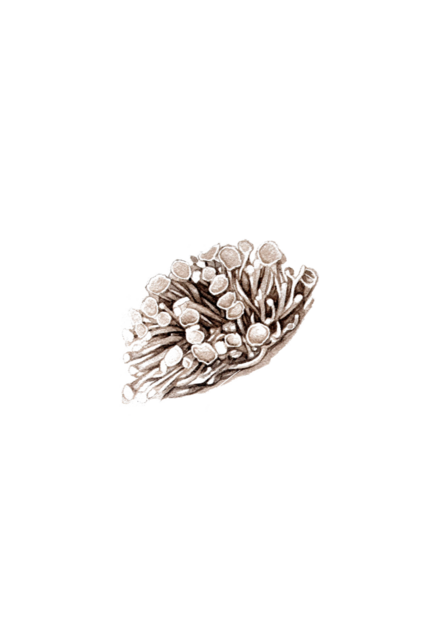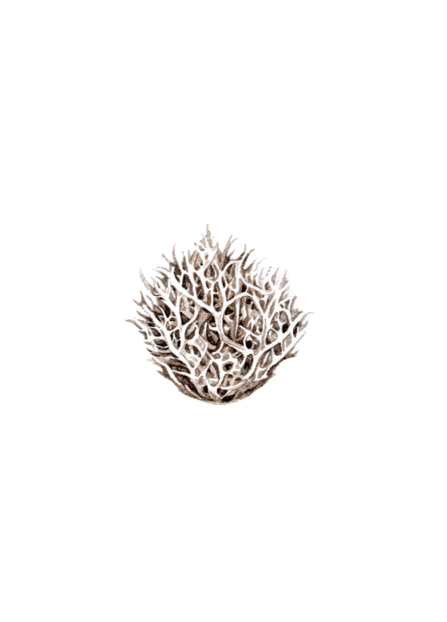Lichens encrust as much as eight percent of the planet’s surface, an area larger than that covered by tropical rainforests. They clad rocks, trees, roofs, fences, cliffs, and the surface of deserts. Some are a drab camouflage. Some are lime green or electric yellow. Some look like stains, others like small shrubs, others like antlers. Some live on beetles, whose lives depend on the camouflage the lichens provide. Untethered lichens—known as “vagrants” or “erratics”— blow around and don’t live their lives on anything in particular. Against the “plain story” of their surroundings, observes Kerry Knudsen, the curator of lichens at the herbarium at the University of California, Riverside, lichens “look like fairy tales.”
Look at a lichen
Lichen by Tom Hibbert

Collin Elder
Lichens have also helped to change the way that life is understood within modern scientific frameworks. Within the body of a lichen, several different organisms come together and collaborate in the building of a new life. Fungi offer physical protection and acquire nutrients. Other partners—algae or photosynthetic bacteria—harvest light and carbon dioxide to make sugars and lipids that provide energy. In 1877, the German botanist Albert Frank coined the word symbiosis to describe the living together of partners within lichens, a word that was soon generalised to refer to the full spectrum of interactions between any type of organism, stretching from parasitism at one pole, to mutually beneficial relationships at the other. Lichens quickly grew into a biological principle that ran against the prevailing currents in evolutionary thought in the late-nineteenth and early-twentieth centuries, best summed up in Thomas Henry Huxley’s portrayal of life as a “gladiator’s show . . . whereby the strongest, the swiftest, and the cunningest live to fight another day.” Lichens were gateway organisms to the idea of inter-kingdom collaboration.
I’ve spent hours absorbed in the worlds that lichens make. The names used to describe lichens sound like afflictions, words that get stuck in your teeth: crustose (crusty), foliose (leafy), squamulose (scaly), leprose (dusty), fruticose (branched). Fruticose lichens drape and tuft; crustose and squamulose lichens creep and seep; foliose lichens layer and flake. Some prefer to live on east-facing surfaces, some on the west. Some choose to live on exposed ledges, others in damp grooves. Some wage slow wars, repelling or disrupting their neighbours. Some inhabit the surfaces left exposed when other lichens have died and flaked off. They come to resemble the archipelagos and continents of an unfamiliar atlas, which is how Rhizocarpon geographicum, or the map lichen, got its name. The oldest surfaces are pitted by centuries of lichenous life and death.

Collin Elder
Lichens’ fondness for rock has changed the face of the planet and continues to do so, sometimes literally. In 2006, the faces of the presidents carved into Mount Rushmore were pressure hosed, removing more than sixty years of lichenous growth in the hope of extending the lifetime of the memorial. The presidents aren’t alone. In 2019, the residents of Easter Island launched a campaign to scrub lichens off hundreds of monumental stone heads, or moai. Described by locals as “leprosy,” lichens are deforming the features of the statues and softening the rock to a “clay-like” consistency. Lichens mine minerals from rock in a twofold process known as weathering. First, they physically break up surfaces by the force of their growth. Second, they deploy an arsenal of powerful acids and mineral-binding compounds to dissolve and digest the rock. Lichens’ ability to weather makes them a geological force, yet they do more than dissolve the physical features of the world. When lichens die and decompose, they give rise to the first soils in new ecosystems. Lichens are how the inanimate mineral mass within rocks is able to cross over into the metabolic cycles of the living. A portion of the minerals in your body is likely to have passed through a lichen at some point. Whether on tombstones in a graveyard or encased within slabs of Antarctic granite, lichens are go-betweens that inhabit the boundary dividing life and nonlife.
Most lichens are very sensitive to pollution, but even in central London you can find tolerant species living on trees or gravestones. If you're feeling lichen curious, a magnifying glass or hand lens is your friend. Try looking at a lichen for at least two minutes—in my experience, the longer I look the stranger they become. You might be moved to draw the lichen, or describe it in a few sentences. Or just consider the living riddles they pose. Lichens are places where an organism unravels into an ecosystem and where an ecosystem congeals into an organism. They flicker between “wholes” and “collections of parts.” Shuttling between the two perspectives can feel strange. The word individual comes from the Latin meaning “undividable.” Is the whole lichen the individual? Or are its constituent members, the parts, the individuals? This confusion is healthy.
Merlin Sheldrake is the author of Entangled Life: How Fungi Make Our Worlds, Change Our Minds and Shape Our Futures out now.

